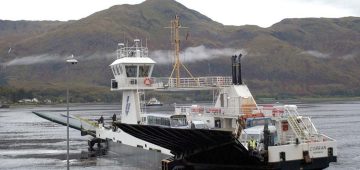CMAL took control of the 8,680gt Loch Seaforth on 7th October whilst German shipyard FSG was in the midst of a takeover by Siem Industries and she was officially handed over on 24th October.
The long anticipated departure from Flensburg came on the morning of 4th November and the Loch Seaforth proudly sailed up the River Clyde dressed overall on the morning of 7th November to berth at Inch Green, Greenock.
The ship is not expected to begin earning revenue across the Minch until the New Year and the week that she reached Scotland the Stornoway berth passenger linkspan was still being installed. The Loch Seaforth cannot enter service until the berth works are complete and, on top of all the delays thus far, it was announced by the Ullapool Harbour Trust just prior to the Loch Seaforth’s arrival that the Ullapool linkspan will need to be closed for around six weeks from November for the 42 year old linkspan to be replaced.

This remarkable planning has left many people scratching their heads as such work should have already been done. Caledonian Macbrayne is making alternative arrangements to transport essential goods to Lewis, possibly to Uig on Skye subject to ship suitability, and a passenger only service will serve Ullapool from Stornoway. Some island traffic may be encouraged to use the Tarbert to Skye service to take the pressure off a direct temporary Skye link.
The procurement process to build and design two new ferries for use on the Clyde and Hebrides Ferry Services network was launched in mid-October by Transport Minister Keith Brown. A Pre- Qualification Questionnaire for the vessels has been issued by Caledonian Maritime Assets Ltd. (CMAL) on behalf of Scottish Ministers. This will allow CMAL to gauge market interest before issuing a formal Invitation to Tender. The successful bidder will undertake detailed design and construction work of two passenger, freight and car ferries of 100 metres length overall, as well as testing, equipping, launch and delivery.
The first vessel is to be delivered by the end of 2017. The second vessel will follow some months later. The new ferries will be fitted with twin LNG dual-fuelled engines and controllable pitch propellers. There will be a requirement for a service speed of 16.5 knots and a carrying capacity of 1,000 passengers, 127 cars or 16 heavy goods vehicles. The ships will also be required to maintain a service speed of 14.5 knots.





Comments
Sorry, comments are closed for this item